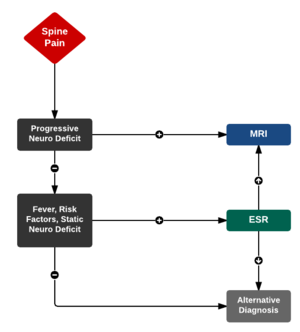We need you! Join our contributor community and become a WikEM editor through our open and transparent promotion process.
Epidural abscess (spinal)
From WikEM
(Redirected from Epidural Abscess)
Contents
Background
- Abscess confined to epidural adipose tissue in spine[1]
- Thoracic and lumbar spine most common; C-spine least common
- Usually spans up to 3-5 vertebral spaces
- Typically hematogenous spread from other source of infection
Organisms[2]
- S. aureus (most common, 2/3 of cases)
- S. epidermidis (associated with device, instrumentation)
- E. coli (urine spread)
- P. aeruginosa (IVDA)
- Rare: anaerobes, mycobacteria, fungi
Risk Factors
- 98% of patients have at least one of the following risk-factors:[3]
- Injection drug use
- Immunocompromised
- Alcohol abuse
- Cancer
- Recent spine procedure
- Recent spine fracture
- Distant site of infection
- Indwelling catheter
- Chronic renal failure
- Diabetes
Epidural compression syndromes
- Spinal cord compression (non-traumatic)
- Cauda equina syndrome
- Conus medullaris syndrome
- Epidural abscess (spinal)
- Epidural hematoma (spinal)
Clinical Features
- Fever + localized back pain is epidural abscess until proven otherwise
- Classic triad of fever, back pain, and neuro deficits is rare (13%)[4]
- Fever is only present in ~50% of cases
Prevalence of Clinical Findings [5]
| Finding | Prevalence |
|---|---|
| Fever (T>38°C) | 19-32% |
| Focal spinal TTP | 52-62% |
| Diffuse spinal TTP | 63-65% |
| Positive SLR | 11-13% |
| Abnormal sensation | 17-27% |
| Weakness | 29-40% |
| Abnormal reflexes | 8-17% |
| Abnormal rectal tone | 5-10% |
| Saddle anesthesia | 2% |
Staging
Progression through stages is highly variable and may evolve rapidly.
- Back pain at affected site
- Nerve root pain from affected level
- Weakness, sensory deficit, bladder/bowel dysfunction
- Paralysis
Differential Diagnosis
Spinal infection
Lower Back Pain
- Spine related
- Acute ligamentous injury
- Acute muscle strain
- Disk herniation (Sciatica)
- Degenerative joint disease
- Spondylolithesis
- Epidural compression syndromes
- Spinal cord compression (non-traumatic)
- Cauda equina syndrome
- Conus medullaris syndrome
- Epidural abscess (spinal)
- Epidural hematoma (spinal)
- Spinal fracture
- Cancer metastasis
- Spinal stenosis
- Transverse myelitis
- Vertebral osteomyelitis
- Ankylosing spondylitis
- Spondylolithesis
- Discitis
- Renal disease
- Intra-abdominal
- Abdominal aortic aneurysm
- Ulcer perforation
- Retrocecal appendicitis
- Large bowel obstruction
- Pancreatitis
- Pelvic disease
- Other
- Retroperitoneal hemorrhage/mass
- Meningitis
Evaluation

A clinical decision algorithm for evaluation of SEA which may decrease diagnostic delay. [6]
Work-up
Labs[7]
- WBC elevated in <45% of patients
- ESR and CRP are almost consistently elevated
- Blood cultures are indicated to identify the source organism (Staph in 2/3 of cases)
CSF[8]
- Gram stain typically negative
- Cultures are positive in <25% of patients
Imaging
- Strongly consider imaging the entire spine to assess for non-contiguous epidural abscess[9]
- MRI with gadolinium is the diagnostic test of choice[10]
- CT with IV contrast may provide usual information regarding bony integrity and fluid collections while awaiting MRI
Management
- Early surgical decompression and drainage[11]
- Aspiration (for diagnosis) and antibiotics may be sufficient for patients without neuro deficits
Antibiotics
- Target Staph, Strep, and Gram-negative bacilli[12]
- Vancomycin 15-20mg/kg BID + metronidazole 500g (7.5mg/kg) q6 hrs + (Cefotaxime or Ceftriaxone or Ceftazidime)
- Ceftazidime is preferred if pseudomonas is considered likely
- Can substitute Nafcillin or Oxacillin for Vancomycin if not MRSA
Treat for 6-8 weeks
Disposition
- Admit
See Also
External Links
References
- ↑ Darouiche RO et al. Bacterial spinal epidural abscess. Review of 43 cases and literature survey. Medicine (Baltimore) 1992; 71:369-85
- ↑ Darouiche RO. Spinal epidural abscess. N Engl J Med. 2006;355(19):2012–2020. doi:10.1056/NEJMra055111.
- ↑ Sampath P, Rigamonti D. Spinal epidural abscess: a review of epidemiology, diagnosis, and treatment. J Spinal Disord 1999; 12:89-93
- ↑ Reihsaus E. et al. Spinal epidural abscess: a meta-analysis of 915 patients. Neurosurg Rev 2000; 23:175-204
- ↑ Davis DP, Wold RM, Patel RJ, et al. The clinical presentation and impact of diagnostic delays on emergency department patients with spinal epidural abscess. J Emerg Med. 2004;26(3):285–291. doi:10.1016/j.jemermed.2003.11.013.
- ↑ Davis DP, Salazar A, Chan TC, Vilke GM. Prospective evaluation of a clinical decision guideline to diagnose spinal epidural abscess in patients who present to the emergency department with spine pain. J Neurosurg Spine. 2011;14(6):765–770. doi:10.3171/2011.1.SPINE1091.
- ↑ Cornett CA, Vincent SA, Crow J, et al. Bacterial spine infections in adults: evaluation and management. Journal of the American Academy of Orthopaedic Surgeons. 2016; 24(1):11-8.
- ↑ Darouiche RO. Spinal epidural abscess. N Engl J Med. 2006; 355(19):2012-2020.
- ↑ Ju, K.L., et al. Predicting Patients with concurrent noncontinguous spinal epidural abscess lesions. Spine J. 2005 15(1):95
- ↑ Angtuaco E. et al. MR imaging of spinal epidural sepsis. Am J Roentgenoli 1987; 149:1249-53
- ↑ Bluman E. et al. Spinal epidural abscess in adults. J Am Acad Orthop Surg 2004; 12:155-163
- ↑ Rigamonti D. et al. Spinal epidural abscess: contemporary trends in etiology, evaluation, and management. Surg Neurol 1999; 52:189-96
